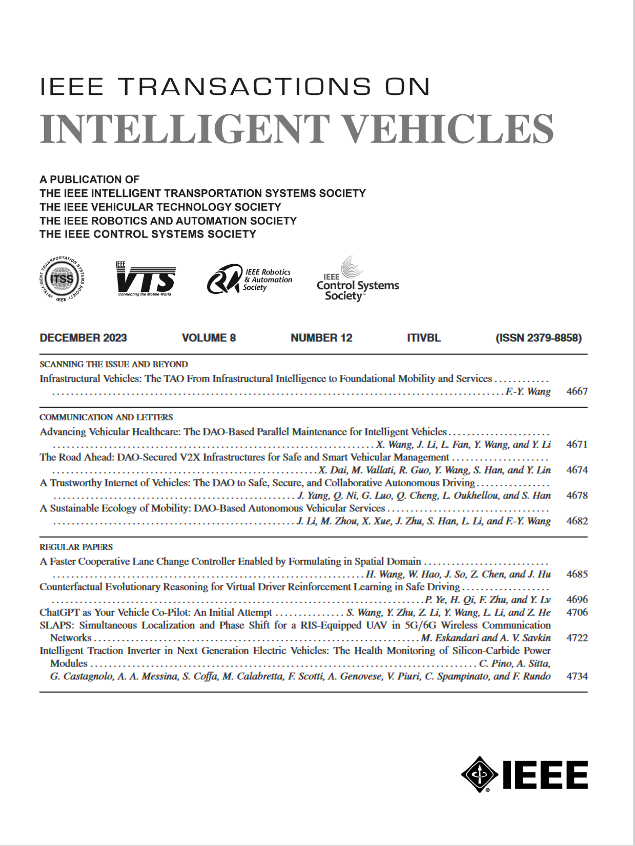An Improved LOS Guidance and Sail-Rudder Cooperative Controller for the Path Tracking of Unmanned Sailboats
IF 14.3
1区 工程技术
Q1 COMPUTER SCIENCE, ARTIFICIAL INTELLIGENCE
引用次数: 0
Abstract
Unmanned sailboats are driven only by wind, making them good platforms for the synchronous observation of air-sea interfaces over a large range. Compared with traditional unmanned ships, the unmanned sailboat involves simultaneous sail and rudder control for path tracking in unpredictable marine environments. The system is characterized by strong coupling and nonlinearity, creating challenges for the design of controllers. This paper combines line-of-sight (LOS) guidance with the introduction of a sideslip angle observer and model predictive control. A high-precision path tracking strategy suitable for cooperative sail and rudder control for unmanned sailboats is proposed. First, considering the lateral error easily caused by the large sideslip angle of sailboats, a full-path fixed-time guidance strategy with double fixed-time sideslip angle observers (DFSO) is proposed. Second, different from the previous strategy of decoupling the sail and rudder to control the speed and heading, the proposed cooperative control framework uses Lyapunov-based model predictive control (LMPC). The sailing speed and heading angle are both accounted for in the objective function, and the stability is verified by Lyapunov theory. Finally, the feasibility and superiority of this proposed method are confirmed by numerical simulation experiments involving the path tracking of a four degree of freedom sailboat model integrated with wind and waves in an ocean environment.一种改进的LOS制导和帆舵协同控制器用于无人驾驶帆船的路径跟踪
无人驾驶帆船仅靠风力驱动,这使得它们成为在大范围内同步观测海空界面的好平台。与传统的无人驾驶船舶相比,无人驾驶帆船需要同时控制帆和舵,以便在不可预测的海洋环境中进行路径跟踪。该系统具有强耦合和非线性的特点,给控制器的设计带来了挑战。本文将视距制导与引入侧滑角观测器和模型预测控制相结合。提出了一种适用于无人驾驶帆船帆舵协同控制的高精度路径跟踪策略。首先,针对帆船大侧滑角容易造成横向误差的问题,提出了一种双侧滑角观测器的全航路定时制导策略。其次,与以往的船舵解耦控制策略不同,本文提出的协同控制框架采用基于lyapunov的模型预测控制(LMPC)。在目标函数中考虑了航速和航向角,并用李亚普诺夫理论验证了系统的稳定性。最后,通过海洋环境下四自由度风浪帆船模型路径跟踪的数值模拟实验,验证了该方法的可行性和优越性。
本文章由计算机程序翻译,如有差异,请以英文原文为准。
求助全文
约1分钟内获得全文
求助全文
来源期刊

IEEE Transactions on Intelligent Vehicles
Mathematics-Control and Optimization
CiteScore
12.10
自引率
13.40%
发文量
177
期刊介绍:
The IEEE Transactions on Intelligent Vehicles (T-IV) is a premier platform for publishing peer-reviewed articles that present innovative research concepts, application results, significant theoretical findings, and application case studies in the field of intelligent vehicles. With a particular emphasis on automated vehicles within roadway environments, T-IV aims to raise awareness of pressing research and application challenges.
Our focus is on providing critical information to the intelligent vehicle community, serving as a dissemination vehicle for IEEE ITS Society members and others interested in learning about the state-of-the-art developments and progress in research and applications related to intelligent vehicles. Join us in advancing knowledge and innovation in this dynamic field.
 求助内容:
求助内容: 应助结果提醒方式:
应助结果提醒方式:


